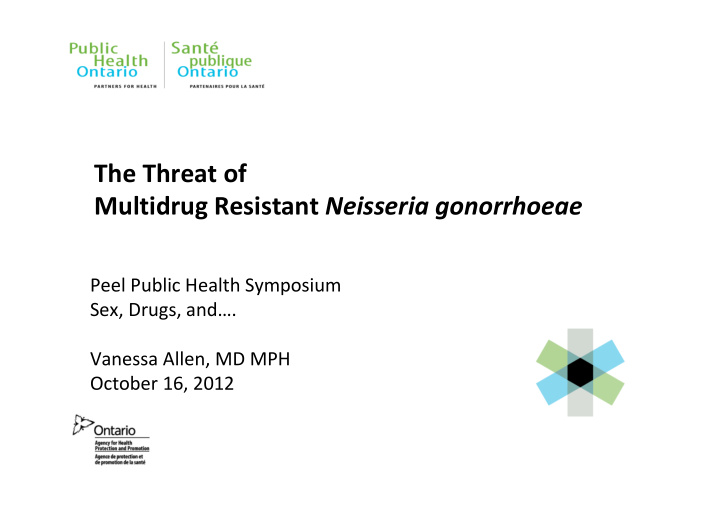



The Threat of Multidrug Resistant Neisseria gonorrhoeae Peel Public Health Symposium Sex, Drugs, and…. Vanessa Allen, MD MPH October 16, 2012
The threat of multidrug resistant gonorrhea • "We're sitting on the edge of a worldwide crisis," says Manjula Lusti-Narasimhan, of WHO's department of reproductive health and research. "There's a general complacency around sexually transmitted infections in general, and this doesn't have the same political or social pressure as HIV. That's because gonorrhea has been so easily curable so far, but in the future, that won't be the case.” http://www.usnews.com/news/articles/2012/06/06/world-health-organization-warns- 2 gonorrhea-could-join-hiv-as-uncurable-
Three Primary Challenges for the Treatment of N. gonorrhoeae 1) Antibiotic resistance • Imminent risk of losing cephalosporins (cefixime and ceftriaxone) This is the last reliable class of antibiotics for the treatment of N. gonorrhoeae • 2) Change in diagnostic testing for N. gonorrhoeae from culture to molecular testing Otherwise called nucleic acid amplification testing (NAAT) • • In 2010, 24.8% were diagnosed by culture at PHO (74.2% NAAT) No susceptibility data available for non-culture specimens • 3) Asymptomatic reservoirs of N. gonorrhoeae infection • Pharyngeal infection particularly difficult to treat with antibiotics • Prompting a recommendation for dual therapy when pharyngeal infection is being considered in CDC 2010 guidelines 3
ANTIBIOTIC RESISTANT NEISSERIA GONORRHOEAE 4
History of antimicrobial resistance in Neisseria gonorrhoeae ���&�� ������ ������-������ ��(&������������� ���������� ���������� +���������� ����������� ����������� ������������� ��.0�� �������� ����������6����� �!�����"#��� $������*��� ������������ ����� &�����#,� ������������� ������������� ����**������ ������ ��������!���� �������� ������� ��5���7����� ��!���5�*������� $������� ����� �����*������� �������������� �������%���� ���������� �������%� ��+�����+����� ��������� ������������ +���������� +��������� ���"#�� ���8�+�� ������������ ����������������� ���������� ������/��������� ��0��� &���'&��(�� +������������� $+������*-���� $���������)$� ��.���/����� ������� ��3���+������� ����**������ ���.�� &����� �,�������� ����**����� ���������*���� �������������� ����������������� ����������� ������������ ����� !���� �������������� ��3��� �������� ����� ��+�����,����� ����������� ��(0�� ��5��� �������,�� ��������� ��������������� ���������� ��0(�� +���*��� +���*��� �� ����������� �*+�������- �+������*-���� *�������� *�������� ���������� �+����*������ ������1� ������������+��� +���������� ������-��� ���������� ������ ��2� $�4����������� ����������� ��� ������ ������������� ��5�����+���#� ��������� ����������� 8�+�� ����� �������� ���� ���� ���� ���� ���� ���� ���� ���� ���� Sequential loss of each class of antimicrobials as effective therapy for Neisseria gonorrhoeae
Proclivity of Neisseria gonorrhoeae to develop antibiotic resistance 1) Transformation with Neisseria species 2) Conjugation 3) Mutations and internal recombination Followed by: •Selection of drug resistant clones when exposed to sub-therapeutic concentrations of antibiotics •Cephalosporin resistance in N. gonorrhoeae • Mosaic penA that encodes for penicillin binding protein (PBP2) Bolan G. et al. N Engl J Med 2012; 366:485-487. February 9, 2012 6
Reduced Susceptibility of N. gonorrhoeae to Cephalosporins in Ontario Fig. 2. Ceftriaxone trends of minimum inhibitory concentrations (MICs) for Ontario N. gonorrhoeae isolates tested between 2005 and 2010* Reduced susceptibility to cefixime defined as > 0.125 mg/L was 8.7% among unique patient isolates in Ontario from May 1, 2010 to April 30, 2011 *2010 isolates are still being tested, data is preliminary Percentages were calculated using the total number of viable Ontario isolates (resistant and susceptible isolates) tested by NML as the denominator. 7
What is the appropriate route and dose of cephalosporin for the treatment of N. gonorrhoeae ? Chisolm SA et al. JAC Aug 2010
Clinical Failures seen in Europe… Nine clinical failures in Ontario in a single clinic in Ontario that performs test of cure
International gonorrhea treatment recommendations ���3���������**��������� 9���������������***��������� /����� &��5 ����,�*������*���:� ;���&��� �������,����&���*��<9��� ����,�*��+��5���*���: ��� �=�����*-�������*��: )$> ��3� �������,����&���*��<9���� >���&��& �������,����&���*��<9 &��� ����,�*������*���: ��� ��� �=�����*-�������*��:���� �=�����*-�������*��:���� ��,-�-����������*���:� ��,-�-����������*���:����� ����?�(���-�� ?�(���-�� )@ &��� �������,����&��*��<9����� 8���� �������,��������*��<9� ����,�*�����*����:��� &��� ��� �+������*-���A�&� �=�����*-������*��: B����� ������ &��. ��+�����,���������*���:� &��� ����,�*������*���:��� :�����=����� �� �������,�����&��*��<9 ����,�*������*���:��� �������,�����&��*��<9��� �+������*-����&��*��<9 8�+�� ' &��0 �������,�������*�<C 10
CHANGE IN DIAGNOSTIC METHODS FOR NEISSERIA GONORRHOEAE 11
Impact of Changing Diagnostic Methods Decreased submissions for culture of N. gonorrhoeae • Introduction of Nucleic Acid Amplification (NAAT) • NAAT available as a duplex (with Chlamydia) and monoplex tests • Recommendation in the US to screen all women aged 15-26 for asymptomatic infection • Ease of collection and transportation/storage requirements • Urine and vaginal collection sites in addition to urethral and cervical • Increased sensitivity (with concurrent loss of specificity) • ~ 95% for NAAT vs 85-95% for culture • But, antimicrobial testing is not possible for NAAT specimens
Lack of routine test of cure • Public Health Agency of Canada recommends test of cure in the following circumstances • Recommended on a routine basis in 2011 UK guidelines • For alternative treatments in CDC guidelines (2012) PHAC Guidelines 2010. http://www.phac-aspc.gc.ca/std-mts/sti-its/pdf/506gonococcal-eng.pdf UK National Guidelinesfor the Management of Gonorrhoea among Adults www.bashh.org/documents/3611 CDC MMWR Aug 9, 2012 http://www.cdc.gov/mmwr/preview/mmwrhtml/mm6131a3.htm 13
PHARYNGEAL RESERVOIRS OF NEISSERIA GONORRHOEAE 14
Recommend
More recommend